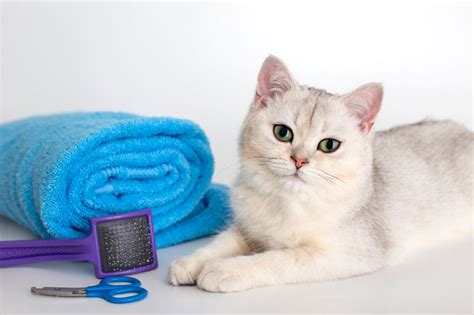Introduction
Cats are fastidious creatures that take pride in their appearance. As pet owners, it’s our responsibility to ensure their well-being, which includes maintaining their fur and overall hygiene. While professional grooming can be beneficial, DIY methods can be just as effective and cost-efficient. This article will explore various DIY grooming techniques and hygiene tips for cats, empowering you to keep your feline companion looking and feeling their best.

DIY Grooming Methods
- Regular Brushing: Brushing your cat’s fur daily will remove loose hair, prevent mats, and distribute natural oils for a healthy coat. Use a slicker brush for short-haired cats and a long-toothed comb for long-haired cats.
- Bathing: Contrary to popular belief, cats do not need frequent baths. Overbathing can strip their skin of its natural oils. However, an occasional bath can help remove excessive dirt or excess oil. Use a mild, unscented shampoo and lukewarm water, rinsing thoroughly.
- Nail Trimming: Trim your cat’s nails regularly to prevent ingrown nails and scratches. Use sharp nail clippers designed specifically for cats.
- Ear Cleaning: Clean your cat’s ears weekly to prevent infection. Use a cotton ball dampened with a mild ear cleaner or hydrogen peroxide (diluted 50:50 with water).
- Dental Care: Dental disease is a common problem in cats. Brush your cat’s teeth regularly with veterinary-approved toothpaste and a soft toothbrush.
Hygiene Tips
- Litter Box Maintenance: Keep your cat’s litter box clean by scooping it daily and changing the litter regularly. A dirty litter box can discourage cats from using it, leading to inappropriate elimination.
- Parasite Prevention: Use flea and tick preventatives regularly, as recommended by your veterinarian. Parasites can cause skin irritation, discomfort, and even transmit diseases.
- Exercise and Play: Provide your cat with ample exercise and play opportunities to maintain its health and well-being. Exercise helps reduce stress and promote coat health.
- Healthy Diet: Feed your cat a balanced, high-quality diet to support its coat and overall health. Consult with your veterinarian for dietary recommendations.
- Regular Vet Checkups: Schedule regular veterinary checkups to ensure your cat’s overall health and discuss any grooming or hygiene concerns.
Benefits of DIY Grooming
- Cost Savings: DIY grooming can save you significant costs compared to professional services.
- Convenience: You can groom your cat at your convenience, without the need for appointments or transportation.
- Bonding Opportunity: Grooming can be a bonding experience, strengthening the bond between you and your cat.
- Peace of Mind: Knowing that your cat is well-groomed and cared for can give you peace of mind.
When to Seek Professional Care
While DIY grooming can be effective, it’s important to seek professional care if you encounter any of the following:
- Persistent Mats or Tangles: If you cannot brush out mats or tangles yourself, a professional groomer may be needed to safely remove them.
- Skin Conditions: If your cat has any skin irritation, redness, or excessive shedding, consult with a veterinarian to rule out underlying medical conditions.
- Dental Disease: Advanced dental disease may require professional cleaning or extractions, which can only be performed by a veterinarian.
- Parasite Infestations: Severe flea or tick infestations may require prescription medications or special treatment by a veterinarian.
- Uncooperative Cats: If your cat is highly uncooperative or aggressive during grooming, professional care may be necessary to ensure safety and well-being.
Case Detail: DIY VS Professional Grooming
A study published in the “Journal of Feline Medicine and Surgery” compared the effectiveness of DIY and professional grooming in 100 cats. The results showed that DIY grooming was just as effective as professional grooming in removing loose hair and preventing mats. However, professional grooming was more effective in removing dirt and debris, as well as in detecting skin conditions.
Tips and Tricks
- Start Grooming Early: Introduce your cat to grooming at a young age to make it a positive experience.
- Use Positive Reinforcement: Reward your cat with treats or praise during and after grooming sessions.
- Consider a Grooming Glove: A grooming glove can be a convenient and gentle way to remove loose hair and stimulate your cat’s skin.
- Avoid Overgrooming: Excessive brushing or bathing can damage your cat’s coat and skin.
- Handle with Care: Always handle your cat gently during grooming, especially when trimming nails or cleaning ears.
Common Mistakes to Avoid
- Overfeeding Your Cat: Obesity can lead to health problems, including skin irritation and dental disease.
- Using Human Products: Human shampoos and conditioners can irritate your cat’s skin.
- Ignoring Dental Care: Dental disease can be painful and lead to serious health problems.
- Neglecting Parasite Prevention: Flea and tick infestations can cause discomfort and transmit diseases.
- Grooming a Sick Cat: If your cat is ill, consult with a veterinarian before grooming them.
Conclusion
DIY grooming methods can be an effective and convenient way to maintain your cat’s health and hygiene. By following the techniques and tips outlined in this article, you can ensure that your feline companion looks and feels their best. However, it’s important to seek professional care when necessary, especially if you encounter any skin conditions, dental problems, or severe parasite infestations. By providing your cat with regular grooming, hygiene care, and a healthy lifestyle, you can contribute to their overall well-being and longevity.





















